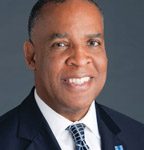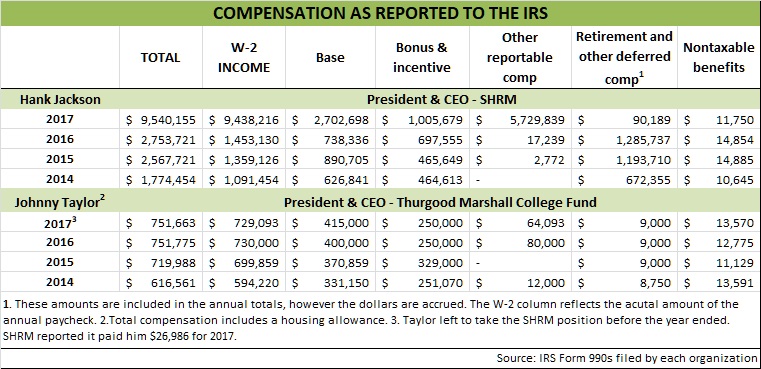In his last year as SHRM CEO, Henry Jackson was paid $9.4 million, an amount larger than any of the top executives of the trade and professional associations tracked by CEO Update.

Jackson’s paycheck included a $5.7 million payout from a supplemental executive retirement plan. But even excluding that payout, Jackson’s $2.7 million base pay and his $1 million bonus puts him ahead — well ahead in many cases — of others on the list of the 25 best paid association CEOs compiled by CEO Update.
“SHRM’s 2017 payout to its CEO is the largest we’ve seen to any association CEO for the 2017 tax year,” said CEO Update Managing Director Mark Graham. “Jackson’s salary is the highest reported in a national trade or professional society since 2013, when American Petroleum Institute paid former CEO Jack Gerard $13.3M, again boosted significantly from a deferred payout.”
Graham, who has tracked CEO pay for a decade, observed that Jackson’s average pay since becoming CEO was $2.3 million, including bonus. “The median take-home pay for CEOs leading a professional society with more than $100M in revenue is about $1M,”Graham noted. “That said, there are very few $100M professional societies to draw comparisons. Jackson’s average salary during his tenure is more akin to those leading large, influential trade groups in the energy or banking sectors.”

The compensation information comes from the tax return non-profits are required to file. With automatic extensions, most returns for 2017 only became available in November. It can take the IRS months to process them and post them online. CEO Update gets copies of the returns directly from the organizations, which are required to make them available to the public. The numbers in this article come from the 990 returns for SHRM, and the Thurgood Marshall College Fund, where Johnny Taylor, SHRM’s current president and CEO was previously employed.

Taylor’s last annual paycheck before taking over as SHRM CEO in January 2018 totaled $751,663 including retirement and benefits. His base pay as president and CEO of the College Fund was $415,000 and his bonus came to $250,000.
Taylor, who joined SHRM during a transition period prior to Jackson’s Dec. 31, 2017 retirement, was paid $26,986 by the organization in 2017.
Asked for his CEO compensation now, SHRM Media and Public Affairs Director Kate Kennedy provided no numbers, saying only, “The CEO Update article was based on the most recent IRS Form 990, which reflects the previous year. Information for 2018 will be in the next Form 990.” When I followed up, asking if it would be “fair then to say SHRM declined to provide those numbers?” Kennedy responded, “No, I wouldn’t say that. Total compensation includes pension. Those actual numbers are not yet available. The Form 990 is a thorough recording of financial info, which is why I suggested reporting from that.”
Commenting on the Jackson payout, Kennedy said:
“The final compensation of SHRM’s retired CEO, Hank Jackson, was significantly influenced by one-time retirement payments (which are included on the Form 990 in his base compensation for 2017) — compensation that was deferred for more than a decade.
Hank retired as CEO in November 2017 after more than seven years as the chief executive officer and 12 years of total service to the association.
SHRM’s CEO compensation is composed of a base salary and bonus based on past years’ performance, along with retirement and other employee benefits…
CEO Update noted that its CEO compensation analysis was incomplete. Missing from its reporting was data from other top associations, which is important for putting SHRM executive compensation in context.”
Kennedy did not respond to a question about the comments on social media, discussing the CEO Update article. Several Facebook comments expressed surprise at the size of Jackson’s paycheck. “Insane,” said one person. “Wow,” said another. “There are no adequate words.”
“NONE of this ever trickles down to the ‘rank-and-file’ SHRM members. They have NO idea,” posted another.
In an email, Gerry Crispin, principal and co-founder of the recruiting consultancy CareerXroads, observed, “In 2017, setting aside Hank’s parting deferred pay, and association pay out for his retirement, his compensation and pay was the 5th largest of 500 Association CEOs whose organizations record revenue of 14 million dollars or greater.”
A member of the SHRM Members for Transparency group which, as the name suggests, sought for greater public information about SHRM board activities, Crispin said in his email, “I am a ‘customer’ of Amazon. I’m an ‘alumnus’ of my University and, in the past, a ‘member’ of SHRM. I don’t have much more than a passing interest in how much Amazon or Jeff Bezos makes… I am however heavily and naturally invested in the places that fostered my engineering education and claim to lead and advance my profession. I want a professional association to demonstrate that my ‘investment’ is being used well. That means providing me in a proactive way with information about our initiatives, assets, costs and rewards and being transparency every aspect.”
The Transparency group formed in 2010 after the SHRM board that year quietly voted to give itself a raise, increasing from $10,000 to $15,000 regular members were paid with higher amounts for Board members serving as committee chairs and $35,000 for the Board chair. In 2017, according to SHRM’s tax return, board members were paid $20,318 with board chair Coretha Rushing paid $35,318.
In an article reporting the 2010 vote, former TLNT Editor John Hollon said, “Longtime observers of the SHRM Board say that this focus on secrecy was not the case in the past, when the attitude was that SHRM members deserved to know what Board members were getting in exchange for their service, but grew during Johnny Taylor’s time as Board chair in 2005. Taylor, many close observers of the Board say, brought a highly political attitude to the SHRM Board during his term as Chair, and that included a strong push to be highly confidential and less than transparent about SHRM Board meetings.”
